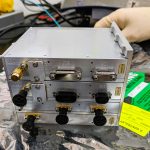Home > Newsletter > Constell'Actions November 2023

Constell'Actions n°4
November 2023
- Nanosatellite: delivery of payload for first flight model
- Successes for the technical qualification tests of the satellite separation sequence with the launcher
- Ambitious preparations for the satellites's next "routine" Technical Qualifications tests
- Kinéis Teams improve uplink and downlink quality between satellites and deployed Ground Remote Stations

KINÉIS CONSTELL’ ACTIONS
Kinéis Constell'Actions is the monthly newsletter dedicated to progress on the design and deployment of the Kinéis connectivity system for the Internet of Things (IoT). GRS teams have conducted a site review to improve communications between orbiting satellites and ground stations. The technical teams are busier than ever around our Proto-Flight Model to validate its technical qualification tests before the industrialization phase. The mobilization of our teams and partners remains intact to ensure the 5 launches of the Kinéis constellation into orbit in 2024. Welcome on board and enjoy your reading!
NANOSATELLITE:
DELIVERY OF PAYLOAD FOR FIRST FLIGHT MODEL
Kinéis has taken delivery of the first flight payload (CU), which will shortly be mounted on the 1st satellite in the constellation. This CU flight model is the final version of a 4-year development program, which has included a number of different models:
- Electrical model,
- Engineering model,
- Qualification model, etc.
The payload is the part designed to fulfill the mission objectives: ensuring upward and downward communications with user terminals and the ground segment.
The Kinéis payload comprises:
- 2 antennas: 1 UHF-S antenna (1), produced by Cobham and Comat,
- 1 AIS antenna (2), produced by Thales Alenia Space, Cannes,
- 3 electronic devices: 1 IoT receiver, 1 AIS receiver and 1 UHF-S transmitter, produced by Thales Alenia Space (Toulouse) and Syrlinks (Rennes).
Kinéis now has a complete set of payload equipment, and will shortly receive the payloads for the other 4 to complete the first batch (of 5 satellites).



In addition, Thales has just supplied the software for the 2 receivers (IoT and AIS) specifically developed to process the signals received on board. The flight hardware and software are currently undergoing final validation at Syrlinks. Kinéis teams will be carrying out further tests to verify the correct operation and performance of the 2 receivers.
Next step: integration of the 5 elements into the 1st flight model satellite, followed by final electro-magnetic tests in an anechoic chamber.
(1) The UHF antenna enables the satellite to communicate with user terminals deployed on land and at sea (bi-directional link), while the S-band antenna transmits mission data received and processed on board to the ground stations of the Kinéis system.
(2) The AIS antenna represents a technological innovation developed specifically for Kinéis satellites. It is dedicated to the maritime Automatic Identification System (AIS), and more specifically to the reception of anti-collision messages exchanged by ships.
SUCCESSES FOR TECHNICAL QUALIFICATION TESTS OF THE SATELLITE SEPARATION SEQUENCE WITH THE LAUNCHER

As announced in October, the joint Kinéis-CNES teams carried out the technical qualification tests for the delicate Launch Early Operations Phase (LEOP), which took place at the Kinéis Control Center at CNES in Toulouse. Kinéis is responsible for the system tests. These tests were carried out right up to the satellite orbit stabilization phase. The deployment sequence for the solar panels and antennas was supervised, the satellite's transition to survival mode and then to earth pointing was perfectly controlled, and all on-board/ground operation sequences were ultimately successful, both in terms of operations and organization.
Next step: routine QT tests
AMBITIOUS PREPARATIONS FOR THE SATELLITE'S NEXT "ROUTINE" TECHNICAL QUALIFICATION TESTS

The next "routine" technical qualification tests* will take on a more global dimension, and will include all Kinéis system components (except ground stations and the Service Center), with the ambitious aim of running them over 5 days to test the system's robustness. Routine tests will also be supplemented by a "maneuver" TQ, aimed at qualifying all special operations (thruster calibration at the start of life, avoidance maneuvers, maneuvers during extreme solar activity, etc.).
* "Routine" technical qualification tests are part of the system validation tests and validate all exchanges between the various system components, as well as the chronology associated with these exchanges. It also tests the robustness of the ground segment.
KINEIS TEAMS IMPROVE UPLINK AND DOWNLINK QUALITY BETWEEN SATELLITES AND DEPLOYED GROUND STATIONS

Installation of a Kinéis Ground Remote Station in La Réunion island (France)
The engineers in charge of ground station operations have carried out a review of the 11 GRS (Ground Remote Station) sites deployed worldwide for the future Kinéis constellation. The aim of this review, also known as the "masking study campaign", is to improve the uplink and downlink between orbiting satellites and ground stations, for UHF and S-band antennas respectively. Indeed, their transmission and reception qualities can be impaired at installation sites due to the appearance of physical or electro-magnetic obstacles.
While the Kinéis teams take into account all the parameters during the site survey to validate the choice of GRS site, this review also enables them to take better account of the immediate environment in the event of site modification (construction of infrastructures) or the development of flora in the vicinity.
The results obtained have enabled us to readjust the positions of the UHF antennas and improve the calculations of the Kineis satellites for the S-band antenna. This "masking study campaign" completes the site survey and confirms the choice of site, both in terms of optical range and radio frequency. These campaigns will be repeated over the life of the system to ensure optimum connection between satellites and antennas.
Next step: deployment of a Kinéis Ground Remonte Station in Chile


À propos
Créé en 2018, Kinéis est un opérateur IoT satellitaire.
© kineis - IoT everywhere - 2023
Nous contacter
Adresse
11, rue Hermès
31520 Ramonville-Saint-Agne
France
Téléphone
05 61 39 47 00
Liens
FAQ
Espace presse
Newsletter
Actualités
Politique de confidentialité
Politique de cookies
Plan du site
Restons connectés





